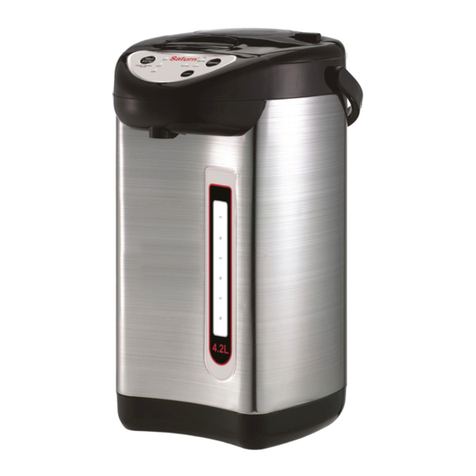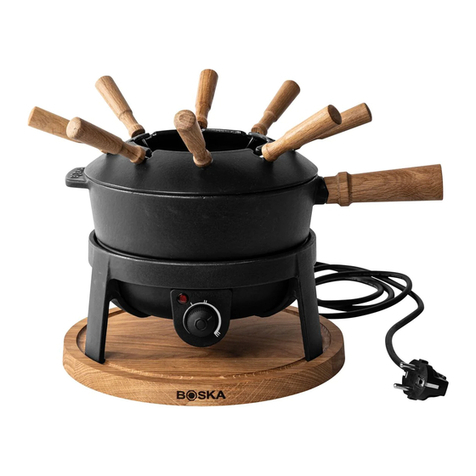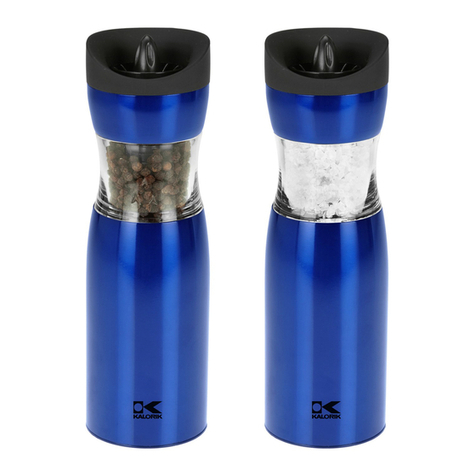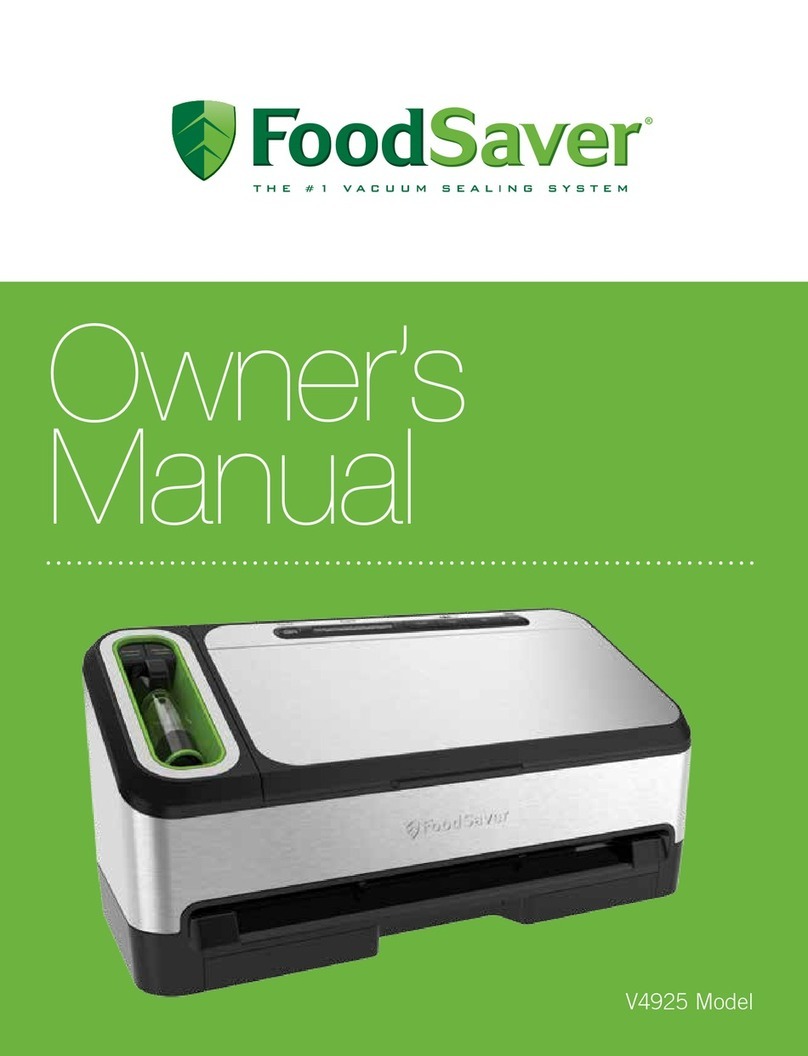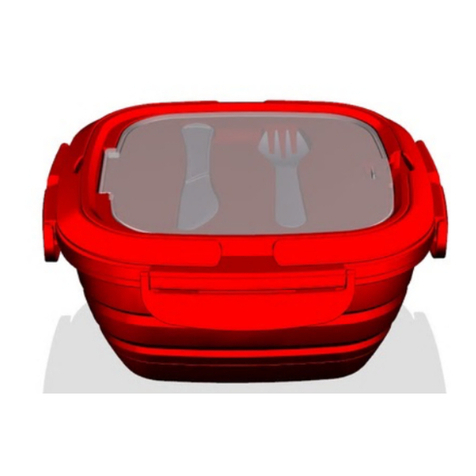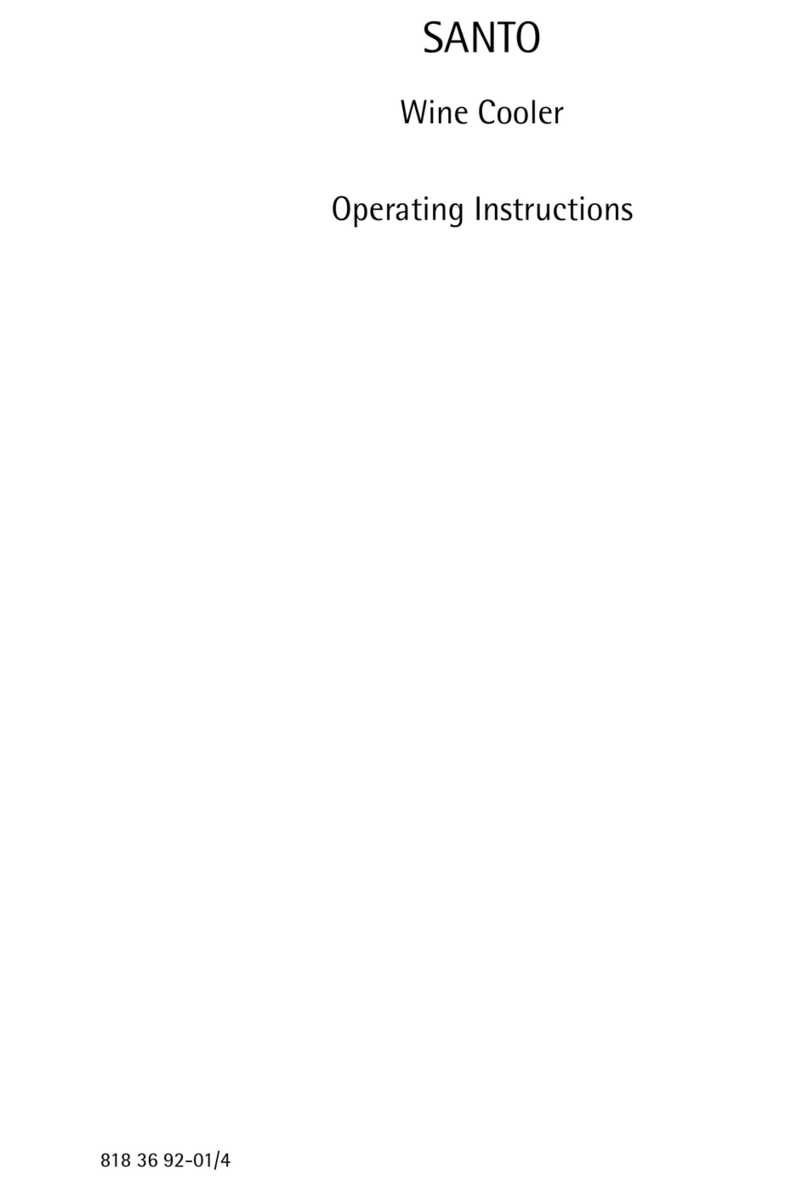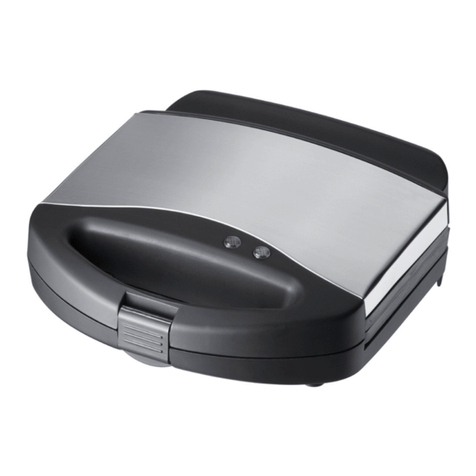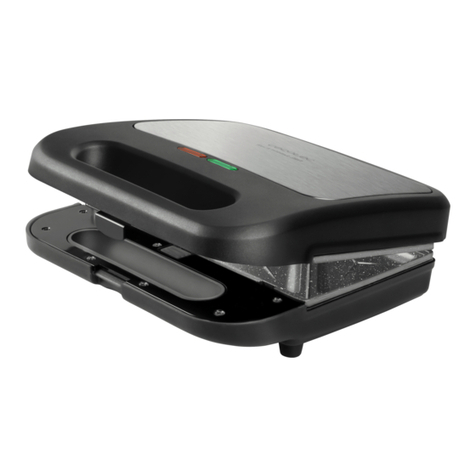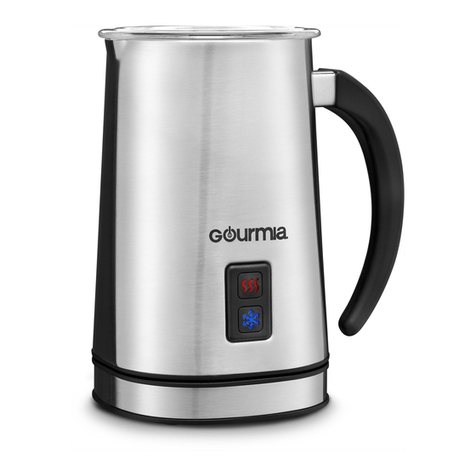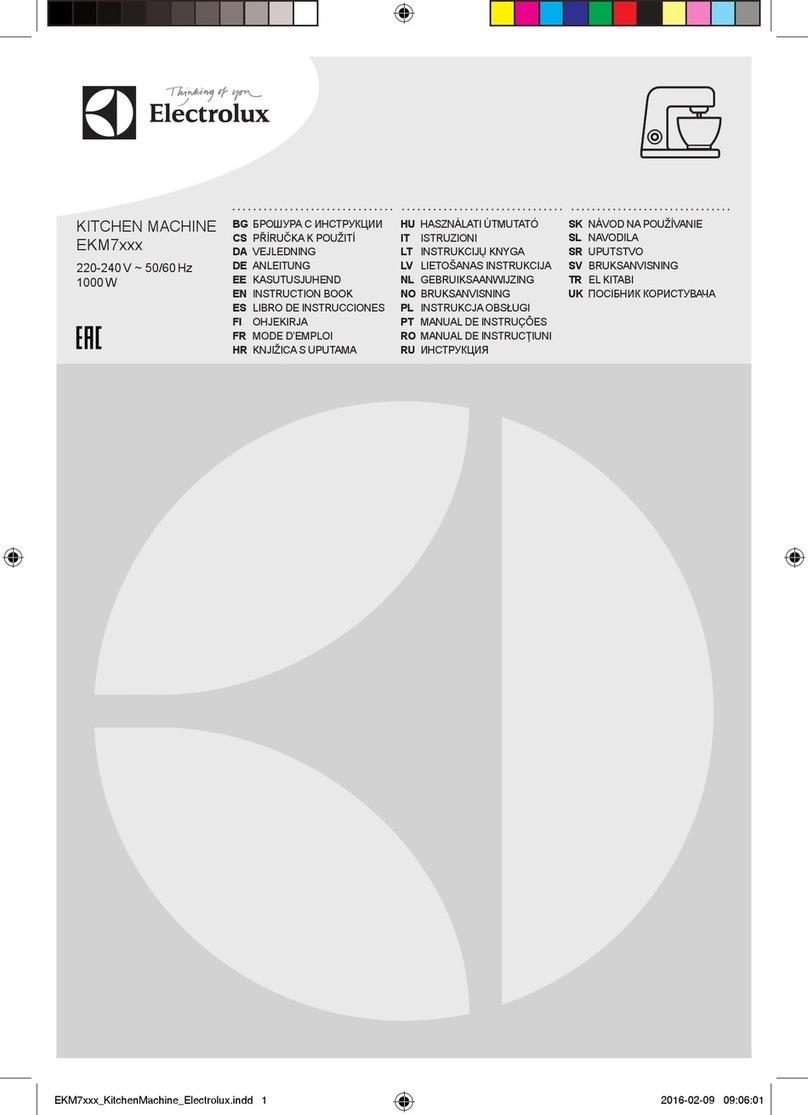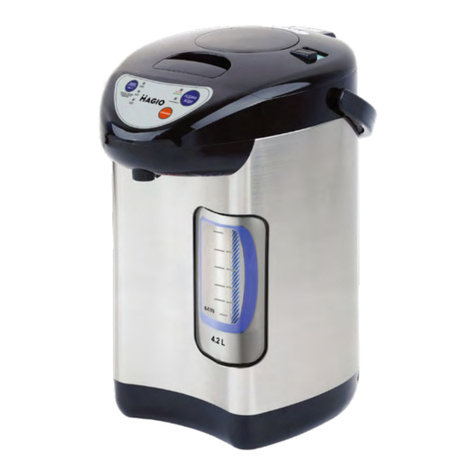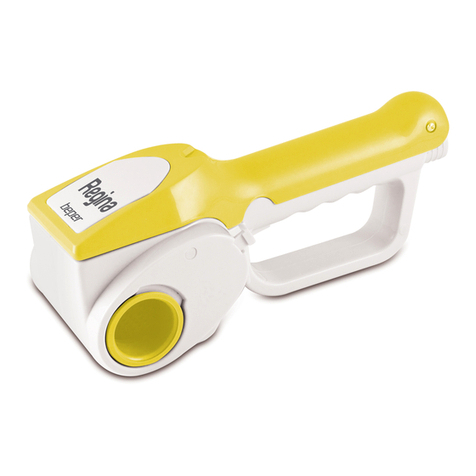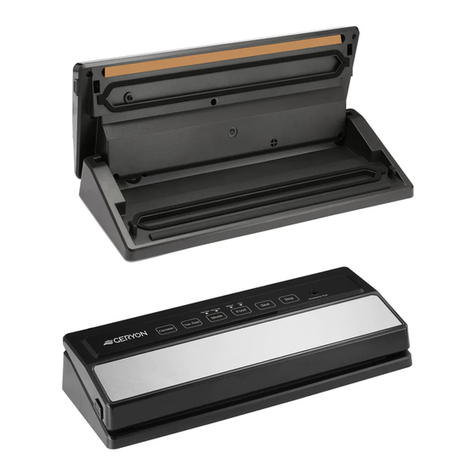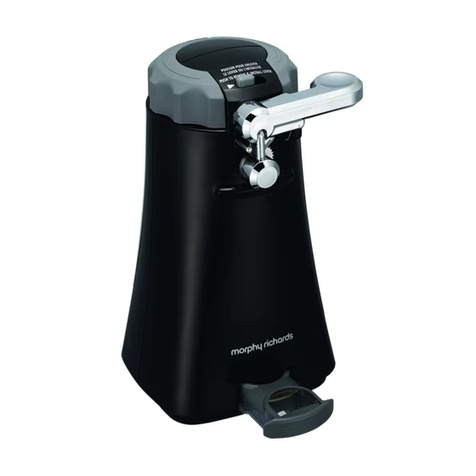RoboLabs Robopop 75 User manual

Vortex popcorn machine
Robopop 75
(VPM-RM4LT)
(VPM-RM4LTUS)
User manual
Read this manual carefully before
use and keep for future reference!
PDF version of this manual is available on www.robolabs.pro

Safety requirements
DO NOT use excessive water while cleaning!
DO NOT disassemble the machine while it is con-
nected to the mains!
Some parts might be hot while in operation!
DO NOT process other kernels than corn!
Only instructed personnel is allowed to operate
the equipment!
DO NOT not leave running machine unattended!
Read and understand all instructions before use!
2

Contents
1 Overview 5
1.1 Purpose ............................. 5
1.2 Technical specifications . . . . . . . . . . . . . . . . . . . . 5
1.3 Deliveryset........................... 5
2 Assembling and Installation 6
2.1 Power requirements . . . . . . . . . . . . . . . . . . . . . . . 6
2.2 Ambient conditions and vent requirements . . . . . . . . . . 6
3 Design and operating principle 7
3.1 Turbine(blower) ........................ 8
3.2 Chamber ............................ 8
3.3 Sifter and scrap tray . . . . . . . . . . . . . . . . . . . . . . 8
3.4 Hopper ............................. 9
3.5 Controlpanel.......................... 9
3.6 Popcorncart .......................... 9
4 Intended use 10
4.1 Modes of operation . . . . . . . . . . . . . . . . . . . . . . . 10
4.2 Operating parameters . . . . . . . . . . . . . . . . . . . . . 11
4.3 Quick start instructions . . . . . . . . . . . . . . . . . . . . 12
4.4 Display notifications . . . . . . . . . . . . . . . . . . . . . . 13
4.5 Forced purge feature . . . . . . . . . . . . . . . . . . . . . . 13
5 Popcorn quality 14
5.1 Rawcorn ............................ 14
5.2 Moisturecontent ........................ 14
5.3 Production capacity . . . . . . . . . . . . . . . . . . . . . . 14
6 Maintenance and cleaning 15
6.1 Outer surface cleaning . . . . . . . . . . . . . . . . . . . . . 15
6.2 Chambercleaning ....................... 15
6.3 Cloggedchamber........................ 16
6.4 Siftercleaning.......................... 17
3

6.5 Sifter rollers cleaning . . . . . . . . . . . . . . . . . . . . . . 17
6.6 Feedercleaning......................... 17
6.7 Conservation .......................... 17
7 Troubleshooting 18
7.1 Toomuchscrap......................... 18
7.2 Popcorn is not crispy . . . . . . . . . . . . . . . . . . . . . . 18
7.3 Err1message.......................... 18
7.4 Err2message.......................... 18
7.5 Err3message.......................... 18
7.6 Err4message.......................... 18
8 Technical manual 19
8.1 Sifter and feeder testing . . . . . . . . . . . . . . . . . . . . 19
8.2 Setupmode........................... 19
8.3 Light bulb replacement . . . . . . . . . . . . . . . . . . . . . 22
8.4 VFDunit ............................ 23
8.5 Temperature limiter setup . . . . . . . . . . . . . . . . . . . 25
8.6 Optical amplifier setup . . . . . . . . . . . . . . . . . . . . . 26
8.7 Electric box layout . . . . . . . . . . . . . . . . . . . . . . . 27
9 Transportation and storage 29
10 Quality control check 29
11 Warranty obligations 30
12 Manufacturer details 30
4

1 Overview
1.1 Purpose
Vortex Popcorn™machine Robopop 75 is a hot-air popcorn making ma-
chine (hereinafter "machine"). It can process both Butterfly and Mush-
room popcorn varieties. Machine is based on patented Vortex technology
that has following advantages:
•No oil is used at all. As a result, popcorn has no carcinogens and
trans-fats; moreover, production cost is lower.
•Once popped, popcorn is immediately removed from the hot area,
thus its nutritional value and taste are kept as much as possible.
The machine is intended for professional use only.
1.2 Technical specifications
Model VPM-RM4LT VPM-RM4LTUS
Throughput up to 34 kg/h up to 34 kg/h
Rated voltage 3N 230/400 V 3P 208–240 V
Rated frequency 50 Hz 60 Hz
Rated power 11,3 kW 11,3 kW
Dimensions (LxWxH) 1370x600x1690 mm 1370x600x1690 mm
Weight 200 kg 200 kg
1.3 Delivery set
Popper 1 pc
Popcorn cart 1 pc
Corn supply tube cleaning brush 1 pc
Plastic bags (LDPE) 50 pcs
Electric compartment key 2 pcs
Spare halogen lamp 1 pc
User manual 1 pc
5

2 Assembling and Installation
Unpack the machine carefully. Check the delivery set. Remove protective
film from all surfaces. Put at the dedicated place, lock all four swivel
casters.
2.1 Power requirements
Power outlet must have grounding contact!
Presence of grounding connection must be checked
on regular basis!
If supply cord damaged, it must be replaced by
manufacturer, service agent, or qualified persons
in order to avoid hazard!
Connections must be done by qualified electrician
ONLY!
For 400 V, 50 Hz service use IEC 60309 3P+N+PE
32 A plug:
For 208–240 V, 60 Hz service use NEMA 15-60P plug:
Equipotential bonding wire (up to 10 sq.mm) shall be
connected to screw terminal marked with IEC 5021
sign:
2.2 Ambient conditions and vent requirements
The equipment must be operated at the ambient temperature from +5◦C
to +40◦C (+41◦F to +104◦F) and relative humidity not more than 45%
at 40◦C (104◦F). The temperature decreasing related to RH increasing,
6

for example, 90% of RH at 20◦C (68◦F). Altitude above sea level should
not exceed 1000 m. Ambient conditions have strong impact on the end
product quality.
A ventilation hood measuring at least 800x800mm
must be provided above the machine, with a min-
imum capacity of 750 m3/h!
3 Design and operating principle
Main components of the machine are: 1 – Turbine; 2 – Chamber; 3 –
Hopper with feeder; 4 – Sifter (perforated drum); 5 – Popcorn cart with
plastic bag; 6 – Scrap tray; 7 – Control panel, see Figure 1.
Figure 1: Robopop 75 main components
7

3.1 Turbine (blower)
The turbine provides constantly circulating airflow inside the machine.
This is a direct type drive; the blower sits on motor’s shaft. Rotational
speed is controlled by the main controller of the machine.
3.2 Chamber
This is where popping happens. Airflow circulates through the chamber;
air is being heated by heating elements. In the chamber’s lower part there
is a bowl with special shaped holes that causes air vortex. During ma-
chine operation corn kernels are being fed into the chamber; kernels are
being heated up, and finally, immediately blown away from the chamber
once popped. Chamber can be easily accessed through the door provided.
Halogen lamp illuminates chamber inside, helping operator to control the
process inside. Chamber is equipped with optical sensor (1) and temper-
ature sensor (2):
Optical sensor is to monitor processes in the chamber. Popper uses sig-
nal from this sensor in order to maintain smooth and effective operation
process. Temperature sensor is to control the temperature in the chamber.
3.3 Sifter and scrap tray
Sifter is a rotating drum with holes that screens un-popped kernels, partly
popped popcorn, and other small fractions into scrap tray located under
the sifter. Scrap tray is easily removable.
8

3.4 Hopper
Corn hopper can fit one standard bag of corn (22,68 kg / 50 Lbs). Equipped
with feeding auger.
3.5 Control panel
1. EMERGENCY STOP push button.
2. 4-digit LED display. Shows parameter
values, alerts and notifications.
3. TEMPERATURE adjusting buttons,
marked with up and down arrows.
4. START/PAUSE push button with light
indicator. This button is used for start-
ing machine, pause mode activation, and
other operating purposes.
5. COOLING/TURN OFF push button.
This button is used to turn machine into
cooling mode, and other operating pur-
poses.
3.6 Popcorn cart
Popper delivery set includes wheeled cart and 200-liter bags set. Cart is
equipped with swivel lockable casters.
9

4 Intended use
4.1 Modes of operation
During operation, the machine is operated in different modes:
Heating mode
Once machine is turned on, it automatically starts to heat up. Upon
reaching certain temperature machine switches automatically to popping
mode.
Popping mode
This is the main operating mode. Machine operates in cyclic way, process-
ing corn kernels batch by batch. Each cycle consists of three stages:
1. Feeding – auger rotates, pushing corn kernels into the chamber.
2. Popping – corn kernels are being heated up in the chamber, even-
tually being blown out from the chamber once popped.
3. Purging – turbine is accelerated to higher speed in order to blow
everything that are left in the chamber, i.e. un-popped kernels, dust
and other scrap.
Pause mode
Machine doesn’t process corn in this mode, but maintains temperature in
the chamber; popping process can be resumed at any time. The sifter
stops after 3 minutes of pause mode.
Cooling mode
Before turning off, machine must be cooled down. In cooling mode heating
elements are completely de-energized; turbine keeps running, cooling down
the machine. Once temperature drops low enough, machine is turned off
automatically.
10

Setup mode
This mode is used for fine adjustment of the machine and also to test
feeder and sifter. For more details see Technical manual section.
4.2 Operating parameters
Properly chosen parameters are essential for good quality product and
stable operation process. Popping temperature and basic turbine speed
are the parameters available for an operator.
Machine misoperation caused by wrong chosen pa-
rameters IS NOT considered as warranty case!
Popping temperature
During operation, the machine maintains the chamber temperature at the
set value. The temperature affects the shape and size of popped pop-
corn. Too high temperature causes smaller popcorn. Too low temperature
reduces capacity, causes improperly popped kernels. Common popping
temperature for Butterfly is between 200-215◦C; for Mushroom it is be-
tween 210-225◦C. Temperature set point can be adjusted during heating
or popping modes. Press and hold one of the adjustment buttons. The
changing value appears on the display. Once desired value is reached,
release the button.
Turbine speed
Turbine speed affects airflow intensity in the chamber. Butterfly corn re-
quires less intense airflow because of the shape; Mushroom requires more
intensive airflow for the same reason. To avoid clogged chamber, it is not
recommended to decrease turbine speed unless the scrap rate exceeds 7%
(compared to the weight of raw corn processed). To change the basic tur-
bine speed, see Technical manual section.
11

4.3 Quick start instructions
1. Empty the scrap tray.
2. Fill the hopper with corn kernels.
3. Put empty plastic bag into popcorn cart and put the cart under the
sifter.
4. Press the START/PAUSE push button to turn the machine on.
5. Once chamber is heated up, the machine is switched in popping mode
automatically.
6. To suspend the process for short time, press the START/PAUSE
push button. The machine will stop making popcorn, but will main-
tain temperature in the chamber at the set value. To resume pop-
ping, press the START/PAUSE push button again.
7. To end the operation, press the COOLING/TURN OFF push but-
ton. The machine stops supply corn to the chamber and is switched
to cooling mode. Once the machine is cool enough, it will be shut
off automatically.
12

4.4 Display notifications
Popper has 4-digit 7-segment LED indicator located on the front panel.
During the operation, the following messages may appear:
Reading Meaning Action required
HHHH Machine is in heating mode None
CCCC Machine is in cooling mode None
POPP (glows) Machine is in popping mode None
POPP (blinks) Machine is in pause mode None
Corn (blinks) Corn is over Add corn
Err1 Turbine fault See Troubleshooting
Err2 Chamber clogged See Troubleshooting
Err3 Temperature sensor fault See Troubleshooting
Err4 Interconnection fault See Troubleshooting
4.5 Forced purge feature
The machine automatically actuates purge procedure during machine op-
eration. However, it is possible to actuate the purge procedure at any time.
If you see that chamber is going to be clogged with popcorn, press and hold
COOLING push button for 3 seconds. The machine executes one purge
cycle. Repeat if necessary. To resume popping, press START/PAUSE
button.
13

5 Popcorn quality
Popcorn is a product that requires ultimate attention towards many as-
pects. Understanding popcorn processing technology is essential to get
high quality product.
5.1 Raw corn
It is impossible to get good stable result using low quality supplies, first of
all, raw corn kernels. Choose reliable corn suppliers. Make sure that raw
corn is stored and handled properly at your production site or warehouse.
Ask your supplier for corn storage recommendations.
5.2 Moisture content
Popcorn is crunchy when its moisture content doesn’t exceed 1-1,5%. Pop-
corn that just came out of the machine has higher moisture rate and tastes
soggy, because it is still losing moisture as cooling down. It is a must to
arrange the workflow in such a way that popcorn has enough time to cool
down before the next stage of processing, e.g. coating. At the same time,
don’t expose popcorn for too long in open containers, because popcorn
starts to take moisture back from the ambient air. Use air-tight containers
if needed to keep popcorn moisture content at the proper level.
5.3 Production capacity
Due to the nature of popping process, there the weight of raw corn pro-
cessed is not the same as the weight of ready-to-eat product at the ma-
chine’s output. The difference is allowed to be up to 20%. Low quality
corn or improperly chosen parameters may increase the weight difference.
For example, if too dry corn used, or there are a lot of damaged kernels,
then there will be a lot of un-popped kernels screened in sifter and dumped
to scrap. Another example, if turbine speed is set too high, a lot of kernels
are blown out before they would have been popped. The scrap rate is
allowed to be up to 5–7% (by weight, compared to the weight of raw corn
processed).
14

6 Maintenance and cleaning
DO NOT use excessive water while cleaning!
ALWAYS unplug the machine from the mains
before cleaning!
DO NOT use sharp tools or abrasives!
Wait until machine is cool before cleaning!
The purpose of maintenance and cleaning is to keep machine in good condi-
tion during all the lifetime and to meet safety requirements. Recommended
cleaning schedule:
Outer surface cleaning every day
Chamber cleaning every day
Sifter cleaning once a week
Sifter rollers cleaning every two weeks
Feeder cleaning every month
6.1 Outer surface cleaning
Clean outer surfaces of the machine with a soft and clean cloth slightly
damped with soap solution. Wipe dry immediately.
6.2 Chamber cleaning
It is necessary to clean the chamber of husk and dust once a day. To clean
the chamber, unfasten the latches which hold the door, and pull it out.
After that, remove husk and debris from the chamber. It is handy to use a
vacuum cleaner for this operation. After cleaning, place the door back and
fasten up the latches. During long time operation, certain amount of corn
15

dust is accumulated in the chamber. It is important to clean mesh screen.
Use a soft brush or a vacuum cleaner to remove dust from the mesh screen.
In case of severe clogged mesh screen do the following.
1. Open the chamber.
2. Remove two bolts (3)
3. Take out the baffler (2).
4. Clean the mesh screen (1).
5. Put the baffler back in the chamber.
6. Fix the baffler with the screws.
6.3 Clogged chamber
The chamber optical sensor provides accurate process of operation. The
new batch won’t be started until the previous batch is evacuated from the
chamber, thus the possibility of clogged chamber is minimal. However,
in case of lack of voltage in the mains, or using Emergency stop button
during the operation, or other reasons, the chamber may get clogged with
popcorn. In such case do the following:
1. DO NOT PANIC!
2. Unplug the machine from the mains.
3. DO NOT open the chamber, DO NOT use fire extinguisher! The
machine is made of stainless steel, as long as chamber door is closed,
popcorn may smolder and smoke, but won’t get fire.
4. Wait until the machine cools down (may take few hours).
5. Open the chamber and clean inside.
16

6. Use the tube cleaning brush from the delivery set to clean the corn
supply tube.
6.4 Sifter cleaning
Take out the sifter drum. Wash it with suitable mild detergents, wipe dry
immediately.
6.5 Sifter rollers cleaning
During operation, the sifter rollers might accumulate corn dust and oil, be-
coming greasy and slippery, affecting normal sifter operation. Thoroughly
clean the sifter rollers’ surface to provide good friction.
6.6 Feeder cleaning
Use a soft dry clean cloth to clean the feeder inner surfaces. It is allowed
to use a vacuum cleaner to remove dust from inside the feeder.
6.7 Conservation
If machine is not used for long time, do all the cleaning procedures.
17

7 Troubleshooting
7.1 Too much scrap
Possible reasons Solution
Low quality corn Use high quality corn
Too high turbine speed Decrease turbine speed
7.2 Popcorn is not crispy
Possible reasons Solution
Low quality corn Use high quality corn
Extreme ambient conditions Provide proper ambient conditions
No exhausting hood Provide exhausting hood
Popcorn is still hot Let popcorn to cool down
7.3 Err 1 message
Turbine speed is below 20 Hz. A qualified technician must be called.
7.4 Err 2 message
Possible reasons Solution
Low quality corn Use high quality corn
Corn storage conditions are bad Provide proper storage conditions
Wrong settings Adjust the settings
7.5 Err 3 message
Temperature sensor fault. A qualified technician must be called.
7.6 Err 4 message
PLC to temperature module connection fault. A qualified technician must
be called.
18

8 Technical manual
This section is for qualified technical personnel only!
8.1 Sifter and feeder testing
Turn the machine off.
Press and hold COOLING button and press START/PAUSE button once;
release COOLING button as you see St-S on the display.
Sifter testing Press and hold COOLING push button. The display will
show St-S message and sifter starts to rotate as long as the button is kept
pressed.
Feeder testing Press and release COOLING push button. The display
will show St-F message and feeder executes one feeding cycle.
8.2 Setup mode
There are two ways to enter the setup mode and change the parameters:
1. If machine is turned off, press and hold COOLING button and press
START/PAUSE button once; release COOLING button as you see
St-S on the display.
2. If machine is running (heating, popping, or cooling mode), press and
hold two temperature adjustment push buttons, the display shows
test, and when you see next reading, release the buttons. The read-
ing will be like P214 , where P represents the current stage of the
machine operation (it can be either H or C for heating or cooling
stage, respectively); and 214 is the current temperature in the cham-
ber.
Press START button to move through the parameters. Use temperature
adjustment push buttons to change the value of the parameter displayed.
19

tP (Time_Popping) Maximal duration of popping stage.
Fr (Feeder_RPM) Corn auger speed (in rpm). The higher the value,
the more corn supplied per batch.
tF (Time_Feeder) Duration of auger operation (in seconds). The
higher the value the more corn supplied per batch.
tb (Time_Boost) Duration of purging stage (in seconds).
tH (Time_Heating) Forced heating period (in seconds) in the begin-
ning of each cycle of operation.
Sr (Sifter_RPM) Sifter rotation speed (in rpm). Low speed can cause
clogged chamber.
FP (Freq_Popping) Turbine speed increment (in Hz) for popping
stage.
Fb (Freq_Boost) Turbine speed increment (in Hz) for purge stage.
Cn (Cnt_Pop) Count threshold for optical sensor in the chamber.
Pt (Temp_P) Proportional band (PID regulation parameter).
It (Temp_I) Integral time (PID regulation parameter).
dt (Temp_d) Derivative time (PID regulation parameter).
tE (Temp_Preheat) During heating stage heaters operated by 90 s
cycles. tE (in seconds) defines the pause between those cycles. For exam-
ple, tE is 60 by default, so heaters are on for 90 s, then they are off for 60
s, and so on. This parameter allows to reach the optimal warm up time
without temperature limiter tripping.
20
This manual suits for next models
2
Table of contents
Other RoboLabs Kitchen Appliance manuals
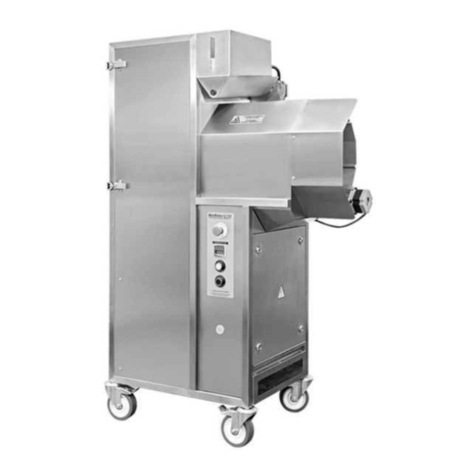
RoboLabs
RoboLabs MINI ROBOPOP 25 User manual
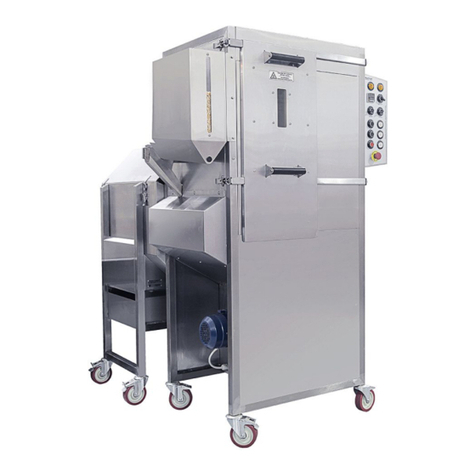
RoboLabs
RoboLabs Grand Robopop 220 User manual
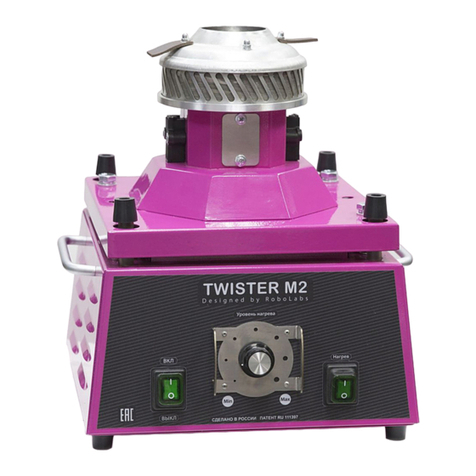
RoboLabs
RoboLabs TWISTER-M2 User manual
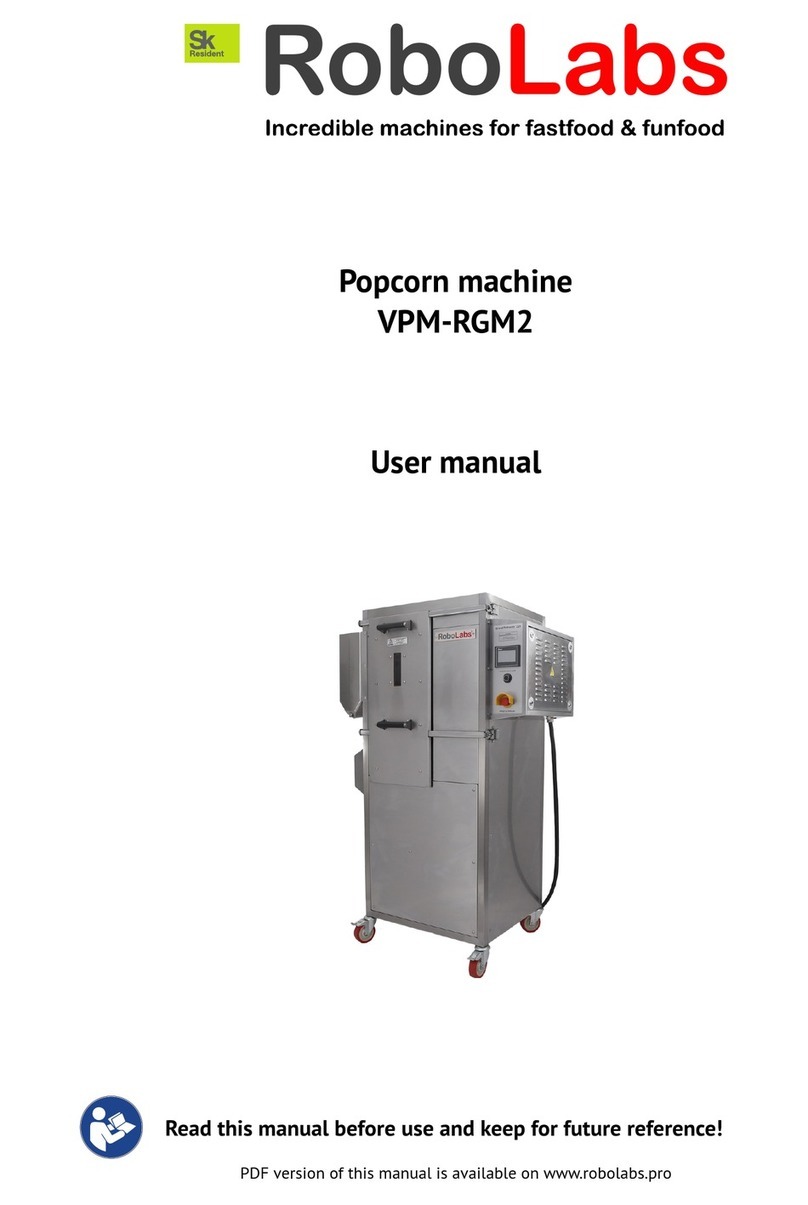
RoboLabs
RoboLabs VPM-RGM2 User manual
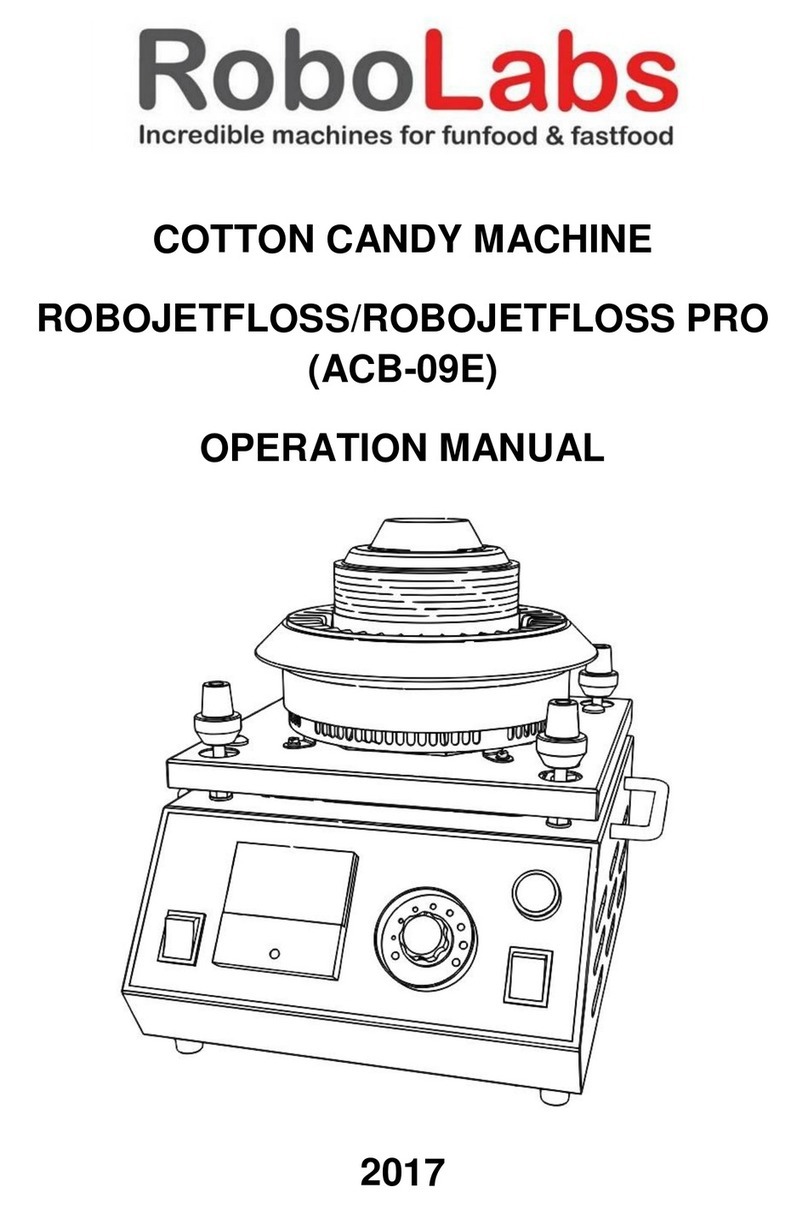
RoboLabs
RoboLabs ROBOJETFLOSS User manual

RoboLabs
RoboLabs ROBOJETFLOSS User manual

RoboLabs
RoboLabs ROBOJETFLOSS ACB-09-120 User manual

RoboLabs
RoboLabs ROBOPOP 60 User manual
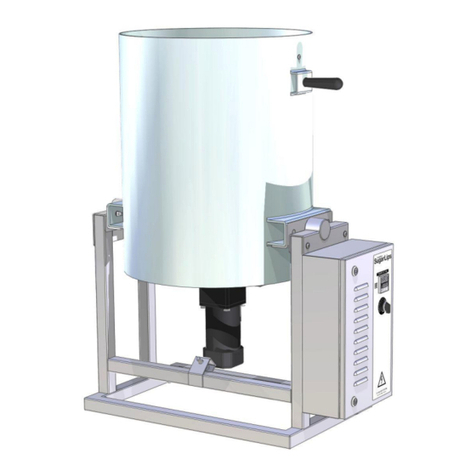
RoboLabs
RoboLabs SUGARLIPS 20 User manual
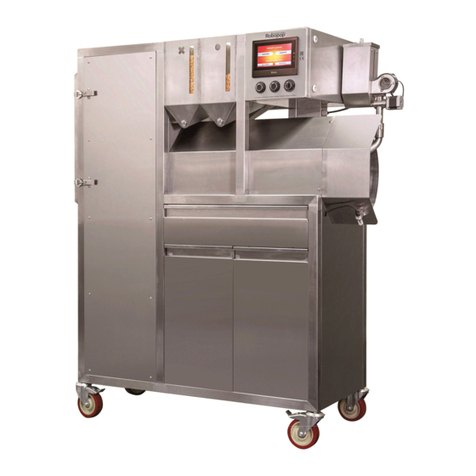
RoboLabs
RoboLabs Vortex Popcorn Robopop 60 Operating manual

